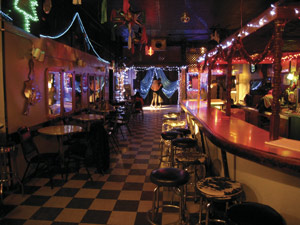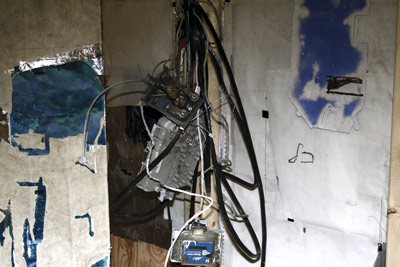Since 1932, the Whitney Biennial, featuring artists who allegedly take the pulse of the visual arts in New York and around the world, is held under the same roof. What was the outstanding thing about this year’s edition then? Let’s start by saying that, since a museum of visual arts was the main venue, the event is no longer a biennial for just that area. This time around, nearly 85 percent of the fourth floor has been turned into a huge dais devoted to dance, performance, music and different activities that are not exclusively centered on painting, sculpturing, drawing, printing, mixed techniques, photography or installations. This is not negative, but rather a confirmation that borderlines are becoming increasingly blurred in a bid to achieve an enriching crossing. An area empowers the other and democracy survives in some place.
Depending on the day and time you get to the Biennial, this year you could find trials, resident artists, musicians performing new compositions, a performance that has no bearings with one or other activities taking place on another of the museum’s floors. The programming is diverse and it changes along the three months the Biennial stretches out for. The presence of films is guaranteed. If something like this ever happened before, it certainly was to a much smaller scale. Variety has intensified and, in addition, there’s less crowding in the halls, less confusion and less need to call the viewers’ attention. Different generations stand their own grounds, and so do their techniques and materials. There’s a stronger creative will and no lack of indispensable themes with known proposals that get a second wind, like the testimonial photography of La Toya Ruby Frazier and the conceptual relationship this young artist sets up with her works. Social topics, autobiographies, enduring African-American themes and social destructions triggered by globalization are all present in pictures and videos.
 I usually start on the fifth floor and go down from there. Right there, Lutz Bacher develops a suggestive and undefined relation between music and text or image. An old Yamaha organ restored with bamboo is now programmed by computers. The images come from an astronomy book and cater to the expression of vastness that tries to express itself on other floors. The player piano equipped with punched rolls in a combination of authors and Georgia Sagri’s work round out the floor layout. Sagri’s idea is far more interesting than the end results, even though I came to watch the Biennial four times. Let’s recall that for the most part, the 2012 Whitney Biennial is a work in progress, and a clear-cut example of that is the “living book” presented by this New York-based Greek artist. It’s an interaction between performance and installation –when it’s not a performance, clothes, a huge piece of plastic on the floor with scattered elements that make up the installation countenance. Without any intention to present a traditional book, Georgia Sagri –working with politicians, the public, philosophers, artists, organizers and activists- wants to point back to the blurry figure of the author –as the boundaries among author, individual and group, between producer and product, fade away. A necessary critique of this original work is that this is far seen more evidently in television than in books.
I usually start on the fifth floor and go down from there. Right there, Lutz Bacher develops a suggestive and undefined relation between music and text or image. An old Yamaha organ restored with bamboo is now programmed by computers. The images come from an astronomy book and cater to the expression of vastness that tries to express itself on other floors. The player piano equipped with punched rolls in a combination of authors and Georgia Sagri’s work round out the floor layout. Sagri’s idea is far more interesting than the end results, even though I came to watch the Biennial four times. Let’s recall that for the most part, the 2012 Whitney Biennial is a work in progress, and a clear-cut example of that is the “living book” presented by this New York-based Greek artist. It’s an interaction between performance and installation –when it’s not a performance, clothes, a huge piece of plastic on the floor with scattered elements that make up the installation countenance. Without any intention to present a traditional book, Georgia Sagri –working with politicians, the public, philosophers, artists, organizers and activists- wants to point back to the blurry figure of the author –as the boundaries among author, individual and group, between producer and product, fade away. A necessary critique of this original work is that this is far seen more evidently in television than in books.
A flight of stairs gives us some fresh air to continue feasting on this banquet. On the fourth floor, in addition to checking on different programs –quite significant when it comes to dancing and music- only the remaining 15 percent is left to see. Behind a huge wall, Wu Tsang’s Green Room stands as a makeup place for artists with certain “things” that cannot be touched, according to the security guard, and yet they are tempting because it feels like being behind the scenes: mirrors and notes on a table, a chair and a California-style video transgender, with two channels, complete his presentation. In the realm of movies, Luther Price’s work is a must, featuring slides, film and video intervened on the basis of visual detritus, dust and everything that appeals to the author in his effort to alter the originals. This is only a mention to the vast program the Whitney Biennial always has to offer in terms of cinema. A four-sided collaboration by Gisele Vienne, Dennis Cooper, Peter Rehberg and Stephen O’Malley delivers an animatronic marionette of a kid who speaks emotively with his puppet about his hardships. Next to it, there are some drawings made with mixed techniques. A sequence of theories and operations that binds the masculine and the feminine in just one piece, authored by Forrest Bess, encouraged Robert Gober to curate for this biennial a hall loaded with paintings and documents that belonged to F. Bess –just as he wanted them to be- and his gallerist never accepted. It’s like a two-way street: installation and homage is what Nick Mauss has created as he makes us run through a doorway to get to an odd space made up of three walls and wallpapered in velvet, reproducing the design created by charismatic Christian Bérard for Guerlain.
 The Biennial also showcases paintings, sculptures, photographs, prints and embroideries –what some people now call the “traditional techniques.” Elaine Reicheck comes up with a solid and personal interrelation between handmade embroidery –the past- and works embossed with the help of digital machines –the non-conceptual present. She provides a conceptual approach to the Ariadma myth and others the artist refers to by means of figures and words. Vincent Fecteau presents a system of sculptures that come on through overlapped clay, cement, resin and paint with a textural touch of sorts or even semifigurative that eventually dies out. Dawn Kasper hasn’t had a studio since 2008 and works in what he has called Experimental Practice of Nomade Studio. Each day, he comes in, changes and provides music. The concept is good, but the end result is nothing new. And he refers to what’s mentioned in another part of the text: the Biennial is a work in progress, that is, like life itself. That’s also what Kate Levant develops in her own way, in a more pictorial-sculpturing-installation-oriented fashion: rescuing materials from a house on fire, she speaks of the zigzagging journey between life and death. Andrew Masullo paints in oil, using bright colors that he never mixes and refers to in an articulation of plane, geometric forms with minimal inclinations of charting games, original geographies, featured in small-size artworks.
The Biennial also showcases paintings, sculptures, photographs, prints and embroideries –what some people now call the “traditional techniques.” Elaine Reicheck comes up with a solid and personal interrelation between handmade embroidery –the past- and works embossed with the help of digital machines –the non-conceptual present. She provides a conceptual approach to the Ariadma myth and others the artist refers to by means of figures and words. Vincent Fecteau presents a system of sculptures that come on through overlapped clay, cement, resin and paint with a textural touch of sorts or even semifigurative that eventually dies out. Dawn Kasper hasn’t had a studio since 2008 and works in what he has called Experimental Practice of Nomade Studio. Each day, he comes in, changes and provides music. The concept is good, but the end result is nothing new. And he refers to what’s mentioned in another part of the text: the Biennial is a work in progress, that is, like life itself. That’s also what Kate Levant develops in her own way, in a more pictorial-sculpturing-installation-oriented fashion: rescuing materials from a house on fire, she speaks of the zigzagging journey between life and death. Andrew Masullo paints in oil, using bright colors that he never mixes and refers to in an articulation of plane, geometric forms with minimal inclinations of charting games, original geographies, featured in small-size artworks.
The Occupy Wall Street Movement turned to the Whitney Biennial is a way other social movements of the past claimed from the big-time auction houses, the museums and the fairs: they are systems that benefit the corporations, the collectors and the museums in detriment of art workers. Elisabeth Sussman, Sondra Gilman and Jay Sanders were the curators accompanied by Thomas Beard and Ed Halter. Out of total of 51 artists, the performance dominates the scene just like video did in the past. But this time around, it’s all about actions close to the TV reality shows, involving both reality and viewers in a more direct and less intellectual way.
Related Publications

How Harumi Yamaguchi invented the modern woman in Japan
March 16, 2022












